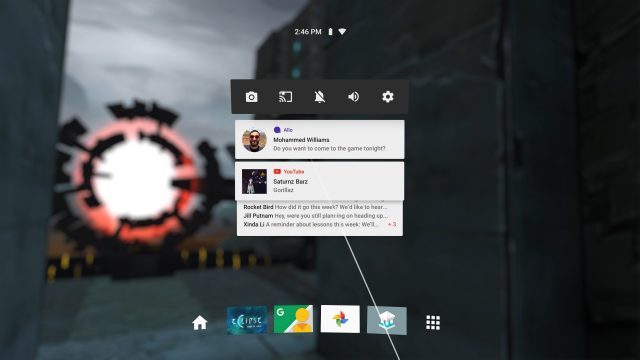Daydream’s 2.0 software update, called Daydream Euphrates, is going to bring along with it some major changes that are set to reach down to the core of the upcoming Android ‘O’ operating system. In a AR/VR press briefing, Google told us there are a number of new systems the update will add across all Daydream headsets, regardless of whether they’re standalone or smartphone-based.
The Android operating system was primarily designed to work on devices with a touchscreen, but with the addition of standalone headsets, this is about to change in a big way. To make the upcoming Android ‘O’ OS more VR-friendly, Google is integrating some things you might think are pretty basic, but in the end are intended to give VR users the tools they need to manage the ‘always in VR’ nature of standalone headsets.
Daydream Home
2.0 will add a dashboard on top of any VR experience so you can check notifications, change settings, pause experiences, and most importantly switch from app-to-app like on a smartphone. This includes support for 2D system UI.
As for the store itself, Google says they want to put content front and center of the Daydream Home experience with an update to the Daydream UI.


While the company contends that 360 video is the most popular type of content people are consuming in VR right now, they’re adding more ways to categorize so that users can easily browse the store for all types of content, bringing Daydream Home more in line with digital marketplaces like Oculus Home and Valve’s SteamVR UI.
Daydream Cast
Google Cast-support is also coming to Daydream devices so people outside of VR can see what you’re doing.
This also means app developers can create cooperative games that involve people outside the headset like VR party game Keep Talking and Nobody Explodes (2015).
Daydream Sharing
Daydream Sharing adds the ability to capture screenshots and screencaptures, and then share them via social media.
[gfycat data_id=”JealousOpenCommabutterfly”]
“This worked really well in Tiltbrush,” a Google spokesperson remarked. “It’s actually one of the number one ways people discover and learn about Tiltbrush – is their friends who are in it post something about it.”
Developer Updates
Developers creating apps for the Daydream platform should take note; there’s also a number of graphics, audio and general performance updates as well.
Graphics
- Multi-process VR compositor
- Multiview stereo rendering
- Multi-layer support
- Vulkan API support
- Support for dual-panel devices
Audio
- Unity and Unreal support
- Wwise and FMOD support
- Real-time early reflection rendering
- Pre-computed room acoustics
- Spatial ambient baking
Performance
- Direct sensors channel
- Just-in-time sensor buffer
- Qualcomm Snapdragon 835 and ARM Mali-G71 support
- VR sleep mode

